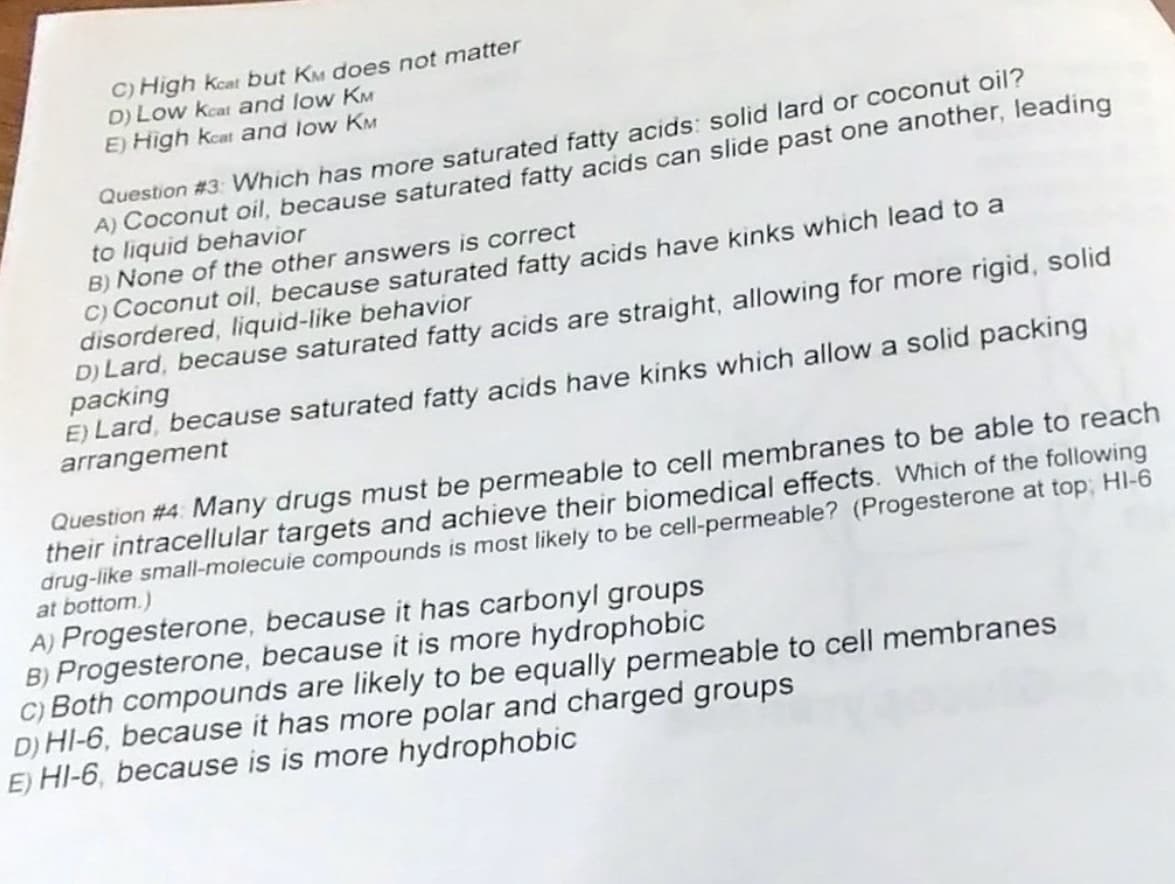C) High kcat but KM does not matter D) Low kcat and low KM E) High kcat and low KM Question # 3: Which has more saturated fatty acids: solid lard or coconut oil? A) Coconut oil, because saturated fatty acids can slide past one another, leading to liquid behavior B) None of the other answers is correct C) Coconut oil, because saturated fatty acids have kinks which lead to a disordered, liquid-like behavior D) Lard, because saturated fatty acids are straight, allowing for more rigid, solid packing E) Lard, because saturated fatty acids have kinks which allow a solid packing arrangement Question # 4: Many drugs must be permeable to cell membranes to be able to reach their intracellular targets and achieve their biomedical effects. Which of the following drug-like small-molecuie compounds is most likely to be cell-permeable? (Progesterone at top; HI-6 at bottom.) A) Progesterone, because it has carbonyl groups B) Progesterone, because it is more hydrophobic C) Both compounds are likely to be equally permeable to cell membranes D) HI-6, because it has more polar and charged groups E) HI-6, because is is more hydrophobic
C) High kcat but KM does not matter D) Low kcat and low KM E) High kcat and low KM Question # 3: Which has more saturated fatty acids: solid lard or coconut oil? A) Coconut oil, because saturated fatty acids can slide past one another, leading to liquid behavior B) None of the other answers is correct C) Coconut oil, because saturated fatty acids have kinks which lead to a disordered, liquid-like behavior D) Lard, because saturated fatty acids are straight, allowing for more rigid, solid packing E) Lard, because saturated fatty acids have kinks which allow a solid packing arrangement Question # 4: Many drugs must be permeable to cell membranes to be able to reach their intracellular targets and achieve their biomedical effects. Which of the following drug-like small-molecuie compounds is most likely to be cell-permeable? (Progesterone at top; HI-6 at bottom.) A) Progesterone, because it has carbonyl groups B) Progesterone, because it is more hydrophobic C) Both compounds are likely to be equally permeable to cell membranes D) HI-6, because it has more polar and charged groups E) HI-6, because is is more hydrophobic
Human Physiology: From Cells to Systems (MindTap Course List)
9th Edition
ISBN:9781285866932
Author:Lauralee Sherwood
Publisher:Lauralee Sherwood
Chapter16: The Digestive System
Section: Chapter Questions
Problem 1SQE
Related questions
Question
Question 3and 4 please

Transcribed Image Text:C) High kcat but KM does not matter
D) Low kcat and low KM
E) High kcat and low KM
Question #3: Which has more saturated fatty acids: solid lard or coconut oil?
A) Coconut oil, because saturated fatty acids can slide past one another, leading
to liquid behavior
B) None of the other answers is correct
C) Coconut oil, because saturated fatty acids have kinks which lead to a
disordered, liquid-like behavior
D) Lard, because saturated fatty acids are straight, allowing for more rigid, solid
packing
E) Lard, because saturated fatty acids have kinks which allow a solid packing
arrangement
Question # 4: Many drugs must be permeable to cell membranes to be able to reach
their intracellular targets and achieve their biomedical effects. Which of the following
drug-like small-molecuie compounds is most likely to be cell-permeable? (Progesterone at top; HI-6
at bottom.)
A) Progesterone, because it has carbonyl groups
B) Progesterone, because it is more hydrophobic
C) Both compounds are likely to be equally permeable to cell membranes
D) HI-6, because it has more polar and charged groups
E) HI-6, because is is more hydrophobic
Expert Solution
This question has been solved!
Explore an expertly crafted, step-by-step solution for a thorough understanding of key concepts.
Step by step
Solved in 2 steps

Recommended textbooks for you

Human Physiology: From Cells to Systems (MindTap …
Biology
ISBN:
9781285866932
Author:
Lauralee Sherwood
Publisher:
Cengage Learning


Human Physiology: From Cells to Systems (MindTap …
Biology
ISBN:
9781285866932
Author:
Lauralee Sherwood
Publisher:
Cengage Learning
